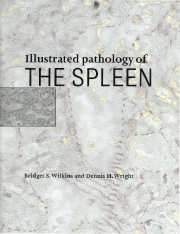Book contents
- Frontmatter
- Contents
- Preface
- Acknowledgements
- 1 Introduction
- 2 Normal structure, development and functions of the spleen
- 3 Post-traumatic and incidentally removed spleens
- 4 The spleen in hereditary blood cell abnormalities and auto-immune disorders
- 5 The spleen in immunodeficiency and systemic infections
- 6 Lymphomas involving the spleen
- 7 The spleen in myeloproliferative disorders
- 8 Pathology of the splenic stroma
- 9 Metastases and miscellaneous conditions
- 10 Summary: some key points in splenic differential diagnosis
- Index
6 - Lymphomas involving the spleen
Published online by Cambridge University Press: 14 August 2009
- Frontmatter
- Contents
- Preface
- Acknowledgements
- 1 Introduction
- 2 Normal structure, development and functions of the spleen
- 3 Post-traumatic and incidentally removed spleens
- 4 The spleen in hereditary blood cell abnormalities and auto-immune disorders
- 5 The spleen in immunodeficiency and systemic infections
- 6 Lymphomas involving the spleen
- 7 The spleen in myeloproliferative disorders
- 8 Pathology of the splenic stroma
- 9 Metastases and miscellaneous conditions
- 10 Summary: some key points in splenic differential diagnosis
- Index
Summary
Introduction
The spleen may be involved in all subtypes of lymphoma. In some cases, e.g. follicle centre cell lymphoma, it may rarely be the dominant or presenting feature. In others, e.g. mycosis fungoides, it is usually a late manifestation, most commonly discovered at post-mortem examination. In some lymphomas, splenic involvement with splenomegaly is a characteristic feature, e.g. hairy cell leukaemia, splenic marginal zone lymphoma and hepatosplenic γδ-T cell lymphoma. Primary lymphomas of the spleen, with the exception of these three entities, are very rare and do not fall into a single subtype. Most such cases are likely to be early dominant manifestations of more generalized disease.
Distinction between subtypes of splenic lymphoma, particularly the small B cell lymphomas, may be difficult. This difficulty is often compounded by poor fixation (see Chapter 1). Reference to the clinical and haematological features of the case is usually of great help. However, this information is not always readily available to the pathologist. Tables 6.1 and 6.2 show a scheme that will allow a pathologist to identify approximately the subtype of lymphoma using the macroscopic appearances and main micro-anatomical features. Precise diagnosis will depend on these micro-anatomical appearances together with cell morphology, immunophenotype and, in some instances, molecular genetic characteristics.
It is always worth searching for lymph nodes at the hilum of the spleen and taking representative blocks. Subtypes of malignant lymphoma are usually easier to identify in involved lymph nodes than in the spleen itself.
- Type
- Chapter
- Information
- Illustrated Pathology of the Spleen , pp. 77 - 110Publisher: Cambridge University PressPrint publication year: 2000
- 2
- Cited by



